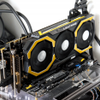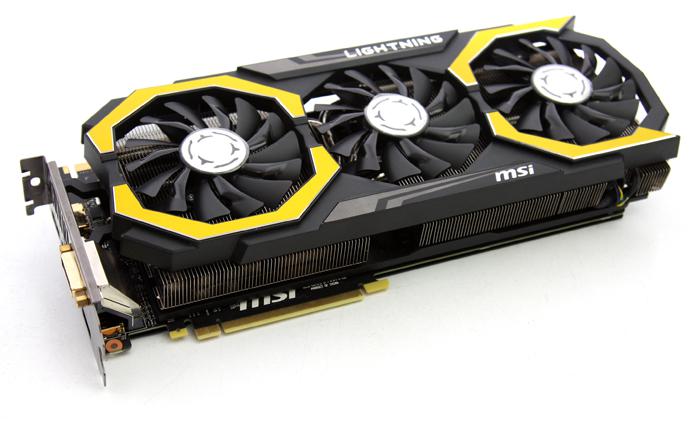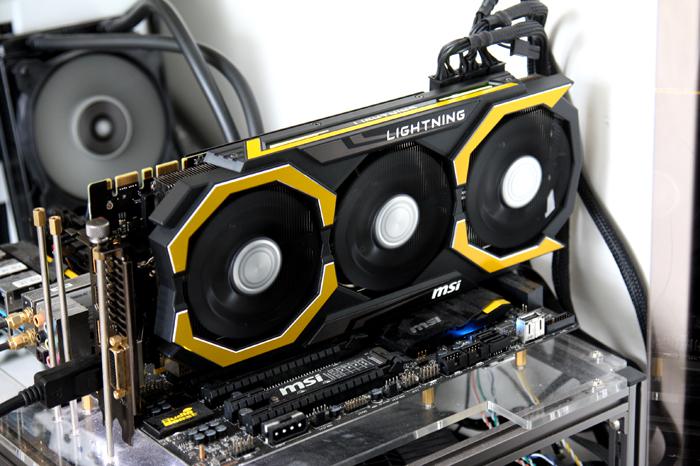Conclusion
Conclusion
The Lightning edition of the GeForce GTX 980 Ti that MSI offers here is a rock solid piece of technology that is bound to impress. The overall design is great, the looks fantastic, the out of the box performance is really good. Aside from the GPU not one bit was left from the Nvidia reference design, this is a graphics card that is totally overhauled. But as impressive as it is, we cannot pass 1500 MHz on this card, which pretty much is similar to what we noticed as well with the competitions liquid cooled Poseidon. It seems that custom boards with their own PWM controllers are more tricky to deal with for the GM-200-310 GPU. So yeah, these boards all clock roughly the same. The Lightning however does come at terrific default clock settings with a Boost clock that passes the 1.3 GHz. Armed with 6GB of graphics memory and combined with the sheer rendering muscle this card has, you'll be future proof for a while. The one question that remains, and I will address this in each and every 980 Ti review, is simple; do you really need a card as beefy as the GTX 980 Ti really is? Well no Sir, not at all if you are playing games in the 1080P or 2560x1440 monitor resolution domain as the GTX 970 or 980 is sufficient. This card offers you to enable any quality settings you desire, and next to that DSR (super-sampling) is slowly becoming popular. With DSR you render at a higher resolution than sample it back to say 2560x1440, and that adds a level of extra image quality as pixels are calculated and rendered more accurately. We have an example of that in our benchmarks session, Shadow of Mordor which we rendered at a whopping Ultra HD and 5K and then output at 2560x1440. And yeah I know, it's all relative but these are options the true enthusiast crowd likes. Then there is Ultra HD, that brute resolution of 3840x2160 requires sheer raw horsepower to output its 4x Full HD resolution, and the GTX 980 Ti is one of two cards that can handle this resolution well with very decent image quality settings. So again, value for money wise you are way better off with a card like the GeForce GTX 970 or 980, make no mistake about that as there is no doubt. But this is enthusiast grade graphics hardware, and yeah it kinda rules. Plus you are a little more future proof with the nice 6GB frame-buffer of course. MSI delivers as promised, the Lightning is seriously fast and has all the variables right when it comes to performance, looks, cooling and noise levels. Tweaking wise things remain a bit standard though the 1.5 GHz domain is obviously nothing to really complain about if you keep the 1 GHz base clock of the reference cards in mind.
Thermals
The Lightning cooler might be huge and rather heavy, but man does it perform well. MSI kept the fan RPM at very low levels, because they can. In idle/desktop mode the fans won't even spin. Once the card reaches 60 Degrees C a very low RPM mode kicks in. All temps are in line as the GPU is sitting at roughly 67 Degrees C under full load. That with the factory overclocked settings. The cooler looks sturdy but might feel a bit bulky, that we have to mention.
Aesthetics
Aesthetically it is a product that is easy on the eyes and will fit any dark and preferably yellow themed gaming PC quite well, yeah the XPower series would match perfectly eh ? My one concern remains the backplate though. Aesthetically it might look please, but we rarely see a backplate based on a single cut-out and we figured that MSI was passed that. The design might look nice (albeit that is subjective as well), but will trap heat.
Cooling versus noise levels
We can’t complain, the cooling solution is just very silent. Expect sound pressure values in the 39 dBA range at max under load and warm circumstances. You can barely hear the thing really. That's measured 75 CM away from the PC. At best you can slightly hear the card while using it heavily. For those that require sheer silence like yours truly, this is the way to go. We have not heard any coil noise or detected whine noises.
Power Consumption
Much like the GM200 Maxwell GPU harbored in Titan X, this GTX 980 Ti is rated as having a 250~260 Watt TDP, our measurements pass that number by a good degree as we measured roughly 300 Watt. It likely is due to the factory overclock, which requires additional voltage. We remain comfortable advising a 650 Watts power supply if you do not go crazy overclocking wise. If you go with 2-way SLI, a 950 Watts power supply is recommended. Remember when purchasing a PSU, aim to double up in Wattage as your PSU is most efficient when it is under 50% load. Here again keep in mind we measure peak power consumption, the average power consumption is a good notch lower depending on GPU utilization. Also, if you plan to overclock the CPU/memory and / or GPU with added voltage, please do purchase a power supply with enough reserve. People often underestimate it, but if you tweak all three aforementioned variables, you can easily add 200 Watts to your peak power consumption budget.
Game Performance
We can't be any clearer about it, all ranges from 1080P to Ultra HD are very playable for the GeForce GTX 980 Ti. Up-to WQHD (2560x1440) this card seems to be a true sweet-spot, however it is really capable of rendering games in that whopper of a resolution Ultra HD as well. You'll be in the 40 FPS on average domain with decent settings and the latest titles mostly, and that's ok. This much game rending horse-power versus the nice 6GB graphics memory helps you in Ultra HD, hefty complex anti-aliasing modes, DSR and of course the latest gaming titles. And that makes this the second viable single GPU solution that allows you to game properly in Ultra HD with some very nice eye candy enabled with a single GPU. Drivers wise we can't complain at all, we did not stumble into any issues. And with a single GPU there's no micro-stuttering to fight off. Performance wise, really there's not one game that won't run seriously good at the very best image quality settings. You must do gaming with a nice 30" monitor of course, at 2560x1440/1600 or Ultra HD.
Overclocking
As stated we expected more as passing the 1.5 GHz barrier was a goal that I figured would be possible, but wasn't. The boost modes can be configured with temperature targets relative to maximum power draw and your GPU Core frequency offsets. Saying that; I realize it sounds complicated but you'll have your things balanced out quite fast as these products are easy to tweak. Our GPU sample could take a 1250~1270 MHz base clock, add to that the dynamic boost clock and you'll see your games rendering in the 1400 to 1500 MHz domain. Realistically I'd say 1.45 GHz is the norm here and if you reach or pass 1.5 GHz, you'll have an excellent yield GPU. The memory you'll be able to get close to roughly 8.7 GHz effective. This card uses Hynix memory btw. Don't push memory too far though, we do recommend adding voltage to that memory with the Lightning as it made a difference (+100 mV). The overclock potential is good, but remains to be just that. We expected a little more from the Lightning tweaking experience. But with a card like this we'll happily take 1.45~1.5 GHz on that GPU core.
Concluding
Every year or so MSI releases a Lightning model, and when I get the news I walk around like a kid waiting on some new toys in my office. Once the new toy arrived I did have that big smile on my face. After three days of testing I am however a little dimmed about my excitement. Hey you guys know me, and I tell it like it is, I expected more tweaking performance from this Lightning model. The 1.5 GHz barrier bother me. As always, tweaking varies per production batch and even per GPU, your results may be much better, but yeah ... also can be worse then ours. I however suspect the limitation we ran into has to do with the custom design and new PWM used. Weirdly enough we noticed the exact same thing on the ASUS Poseidon. Now, I also need to place things in perspective, as aside from that slightly dim tweaking result, this card design is showing near perfection as all the right boxes are ticked from default performance, to it being in-audible, to the nice temps and to its design. The performance is overall faster than a GeForce GTX Titan X, yet pricing should be better at MSRP the 750 USD marker. In the end this product will offer you a AAA gaming experience in any monitor resolution, as even Ultra HD now becomes a viable resolution for single GPU setups. The card does so while keeping itself at nice temperatures. Compared to the GeForce GTX 980 Ti at 2560x1440 you can expect an increase of up-to say 25% performance (over the reference GeForce GTX 980 Ti) and overclocked you can add another 10%. We adore the MSI GeForce GTX 980 Ti Lightning for what it really is, a very fast product with nice aesthetics, excellent noise levels and great cooling performance. With the MSI GeForce GTX 980 Ti Lightning you can flick on all exquisite image quality settings and get yourself submerged into a quality gaming experience. We had hoped for a slightly better OC on air-cooling, though we probably are complaining a little more then needed. The Lighting is a truly sexy product that comes very much so recommended by Guru3D.com. We are awarding the product a Top Pick award as it definitely deserves that.
Small note: the version of AfterBurner we used is an internal beta (hey we develop the software). The current public version does not allow voltage tweaking just yet. We expect to release a new revision of AfterBurner pretty soon in the upcoming weeks (in September), that version will allow triple voltage control (GPU/PLL/MEM) with up-to 1.3 Volts on the GPU right out of the box.
- Sign up to receive a notice when we publish a new article
- Or go back to Guru3D's front page



